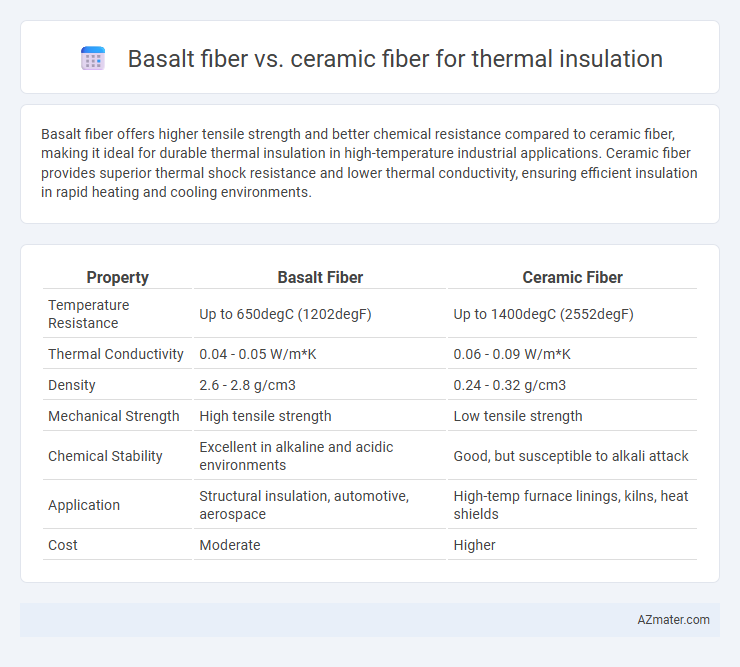Basalt fiber offers higher tensile strength and better chemical resistance compared to ceramic fiber, making it ideal for durable thermal insulation in high-temperature industrial applications. Ceramic fiber provides superior thermal shock resistance and lower thermal conductivity, ensuring efficient insulation in rapid heating and cooling environments.
Table of Comparison
| Property | Basalt Fiber | Ceramic Fiber |
|---|---|---|
| Temperature Resistance | Up to 650degC (1202degF) | Up to 1400degC (2552degF) |
| Thermal Conductivity | 0.04 - 0.05 W/m*K | 0.06 - 0.09 W/m*K |
| Density | 2.6 - 2.8 g/cm3 | 0.24 - 0.32 g/cm3 |
| Mechanical Strength | High tensile strength | Low tensile strength |
| Chemical Stability | Excellent in alkaline and acidic environments | Good, but susceptible to alkali attack |
| Application | Structural insulation, automotive, aerospace | High-temp furnace linings, kilns, heat shields |
| Cost | Moderate | Higher |
Introduction to Thermal Insulation Materials
Basalt fiber and ceramic fiber are advanced thermal insulation materials known for their high-temperature resistance and durability. Basalt fiber, derived from volcanic rock, offers excellent mechanical strength, chemical stability, and eco-friendliness, making it suitable for industrial and construction insulation. Ceramic fiber, composed of alumina and silica, provides superior thermal stability, low thermal conductivity, and lightweight characteristics ideal for furnace linings and high-temperature insulation applications.
Overview of Basalt Fiber
Basalt fiber, derived from volcanic basalt rock, offers exceptional thermal insulation with a melting point around 1450degC, surpassing traditional ceramic fibers in durability and chemical resistance. Its eco-friendly production involves minimal chemical processing, resulting in a sustainable option with high tensile strength and excellent thermal stability. Basalt fiber's superior resistance to thermal shock and corrosion makes it ideal for high-temperature industrial applications compared to ceramic fiber.
Overview of Ceramic Fiber
Ceramic fiber is an inorganic material composed mainly of alumina and silica, offering excellent thermal insulation properties at high temperatures up to 1400degC (2552degF). Its low thermal conductivity, high melting point, and chemical resistance make it ideal for refractory applications and industrial furnaces. Compared to basalt fiber, ceramic fiber provides superior heat resistance but is more brittle and less environmentally friendly.
Thermal Performance Comparison
Basalt fiber exhibits superior thermal stability withstanding continuous temperatures up to 650degC, whereas ceramic fiber endures higher temperatures up to 1260degC but suffers from increased brittleness and fiber degradation over extended use. Basalt fiber's dense structure offers lower thermal conductivity in moderate temperature ranges, providing efficient insulation and enhanced durability under thermal cycling conditions. Ceramic fiber excels in high-temperature insulation with lower heat capacity, making it ideal for extreme heat applications despite its fragility and shorter lifespan compared to basalt fiber.
Mechanical Strength and Durability
Basalt fiber offers superior mechanical strength compared to ceramic fiber, with tensile strength ranging from 2,800 to 4,800 MPa, making it highly resistant to wear and tear in demanding thermal insulation applications. Ceramic fiber, while providing excellent thermal resistance up to 1,260degC to 1,650degC, tends to be more brittle and less durable under mechanical stress or repeated thermal cycling. The enhanced durability of basalt fiber ensures longer service life and reduced maintenance costs in high-temperature insulation environments where mechanical integrity is critical.
Temperature Resistance Capabilities
Basalt fiber offers superior temperature resistance, maintaining structural integrity up to 980degC (1800degF), making it ideal for high-temperature thermal insulation applications. In contrast, ceramic fiber can withstand even higher temperatures, often exceeding 1260degC (2300degF), providing exceptional insulation in extreme heat environments like furnaces and kilns. The choice between basalt and ceramic fibers depends on the required thermal threshold and mechanical durability specific to industrial insulation needs.
Fire and Chemical Resistance
Basalt fiber offers superior fire resistance with a melting point around 1450degC, making it highly effective for thermal insulation in high-temperature environments. Ceramic fiber withstands even higher temperatures, exceeding 1600degC, and provides excellent chemical resistance against alkaline and acidic substances. Both fibers excel in thermal insulation, but ceramic fiber demonstrates enhanced durability in extreme fire and aggressive chemical conditions.
Environmental Impact and Sustainability
Basalt fiber demonstrates superior environmental benefits over ceramic fiber due to its natural volcanic rock origin and lower energy consumption during production, resulting in reduced carbon emissions. Its recyclability and biodegradability contribute to sustainable thermal insulation solutions, minimizing landfill waste compared to ceramic fiber, which relies on synthetic materials and entails higher energy-intensive manufacturing processes. The durability and thermal stability of basalt fiber extend insulation lifespan, further enhancing its eco-friendly profile in sustainable building and industrial applications.
Cost Analysis and Economic Factors
Basalt fiber offers a cost-effective alternative to ceramic fiber for thermal insulation due to its lower raw material and production expenses, leading to reduced overall installation costs. Ceramic fiber, while typically more expensive, provides higher temperature resistance and better thermal performance, which may justify the initial investment in high-temperature applications. Economic factors such as lifecycle cost, durability, and maintenance frequency also impact the total cost of ownership, often making basalt fiber favorable for budget-sensitive projects with moderate temperature requirements.
Best Applications and Industry Uses
Basalt fiber offers high mechanical strength, excellent thermal stability up to 700degC, and superior chemical resistance, making it ideal for automotive parts, aerospace components, and high-performance thermal insulation in industrial furnaces. Ceramic fiber withstands extreme temperatures up to 1600degC, provides low thermal conductivity, and is preferred in refractory linings, kiln insulation, and heat shields for metallurgical and petrochemical industries. Choosing between basalt and ceramic fiber depends on specific temperature requirements, mechanical stress tolerance, and chemical exposure in applications such as fireproof textiles, insulation blankets, and structural composites.

Infographic: Basalt fiber vs Ceramic fiber for Thermal insulation
 azmater.com
azmater.com